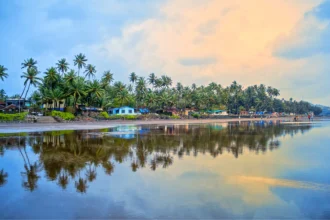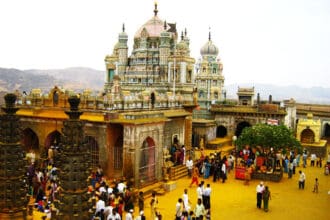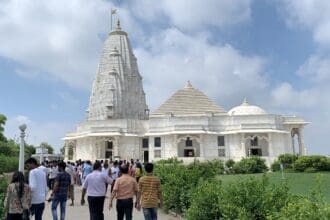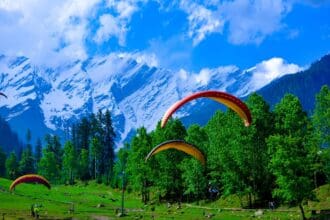Panchgani, nestled in the Western Ghats of Maharashtra, is a serene hill station that offers breathtaking views, lush greenery, and an escape from the chaos of city life. Known for its cool climate, strawberry farms, and scenic beauty, this destination has become a favorite among travelers seeking tranquility and adventure alike. Whether you’re planning a family vacation, a romantic getaway, or a solo trip, Panchgani promises unforgettable experiences. In this guide, we’ll explore the top 5 places to visit in Panchgani , along with hidden gems, local insights, and practical tips to make your journey seamless.
1. Table Land: The Crown Jewel of Panchgani
Why Table Land Stands Out
Table Land is one of the most iconic landmarks in Panchgani and arguably its most photographed spot. This vast, flat plateau stretches across several kilometers and offers panoramic views of the surrounding valleys. It’s particularly famous for its unique geological formation, making it one of the largest volcanic plateaus in Asia. The name “Table Land” comes from its resemblance to a tabletop, as the plateau is almost perfectly flat, offering an uninterrupted view of the horizon.
Activities to Enjoy at Table Land
Visitors can indulge in a variety of activities here:
- Trekking: The trails around Table Land are perfect for beginners and seasoned trekkers alike. The trek begins with a gentle ascent through dense forests, eventually leading to the open expanse of the plateau. Along the way, you’ll encounter diverse flora and fauna, including rare species of birds and butterflies.
- Paragliding: Adventure enthusiasts flock to this location for paragliding sessions that provide bird’s-eye views of the landscape. The thrill of soaring above the hills and valleys is unmatched, and many operators offer tandem flights for first-timers.
- Photography: With its golden sunsets and misty mornings, Table Land is a paradise for photographers. Capture the interplay of light and shadow as the sun rises or sets, casting long shadows over the plateau.
Best Time to Visit
The best time to visit Table Land is during the monsoon season when the entire area comes alive with vibrant greens and cascading waterfalls nearby. However, winter mornings offer crystal-clear skies ideal for photography. During the monsoons, the plateau is often shrouded in mist, adding a mystical charm to the already stunning scenery.
“Table Land isn’t just a tourist attraction; it’s a place where nature speaks directly to your soul.”
Additional Insights
For those interested in geology, Table Land offers a fascinating glimpse into the region’s volcanic past. The plateau was formed millions of years ago due to volcanic activity, and today, it stands as a testament to the powerful forces that shaped the Earth. Educational tours are occasionally organized by local guides who share intriguing facts about the plateau’s formation and its ecological significance.
2. Sydney Point: A Scenic Retreat
What Makes Sydney Point Special?
Named after Lord Sydney, who once governed British India, Sydney Point offers mesmerizing views of the Krishna Valley and Dhom Dam. Located on a cliff edge, this spot provides a vantage point to witness both sunrise and sunset, painting the sky in hues of orange and pink. The viewpoint is especially popular among couples and families, who come here to enjoy picnics while soaking in the natural beauty.
Things to Do at Sydney Point
- Picnics: Families often bring packed meals to enjoy amidst the picturesque surroundings. There are designated picnic areas equipped with benches and shaded spots, making it convenient for visitors to relax.
- Boating: While boating isn’t available at Sydney Point itself, the nearby dam offers opportunities for water sports. Visitors can rent paddle boats or kayaks to explore the calm waters of the reservoir.
- Relaxation: Simply sit back and soak in the serenity while watching the clouds drift by. The cool breeze and soothing sounds of nature create a calming atmosphere, perfect for unwinding after a long day of sightseeing.
Insider Tip
For the best experience, arrive early in the morning to avoid crowds and secure a prime viewing spot. If you’re visiting during the monsoon, be prepared for sudden showers, but don’t let that deter you—rain adds a magical touch to the landscape, with water droplets glistening on leaves and creating rainbows in the distance.
Cultural Significance
Sydney Point holds historical importance as well. During the British colonial era, it served as a retreat for officials and their families. Remnants of old bungalows and structures can still be seen in the vicinity, offering a glimpse into the past. Local historians often conduct guided tours, sharing stories of the people who once called this place home.
3. Parsi Point: Where History Meets Nature
A Glimpse into Parsi Point’s Legacy
Parsi Point derives its name from the Parsi community, which played a significant role in developing Panchgani as a hill station during colonial times. This viewpoint overlooks the Krishna Valley and offers stunning vistas of the lush greenery below. The Parsis were instrumental in establishing schools, hospitals, and other infrastructure that transformed Panchgani into a thriving hill station.
Highlights of Parsi Point
- Historical Significance: Learn about the contributions of the Parsi community to Panchgani’s development. Many Parsi families still reside in the area, continuing their legacy of philanthropy and cultural enrichment.
- Nature Walks: Explore the walking trails that wind through dense forests and lead to secluded spots. These trails are lined with towering trees and colorful flowers, providing a refreshing escape from urban life.
- Birdwatching: The area is home to various avian species, making it a haven for bird lovers. Keep an eye out for peacocks, parakeets, and even migratory birds that visit during certain seasons.
Seasonal Beauty
During the monsoons, Parsi Point transforms into a verdant wonderland with mist-covered hills and gushing streams. The air is filled with the scent of wet earth, and the sound of raindrops hitting leaves creates a symphony of nature. Winter brings clear blue skies and crisp air, ideal for long walks and photography.
Local Legends
There are several legends associated with Parsi Point, passed down through generations. One such tale speaks of a wise sage who meditated here for years, attaining enlightenment. Locals believe that the spiritual energy of the place remains intact, attracting seekers and pilgrims to this day.
4. Rajpuri Caves: Mysteries Beneath the Earth
Exploring the Enigmatic Rajpuri Caves
Rajpuri Caves are ancient caverns believed to have been used by saints and sages for meditation centuries ago. These caves are steeped in mythology and are said to house sacred water tanks known as “kunds.” According to legend, these kunds possess healing properties, and many visitors bathe in them to cleanse their sins and seek blessings.
What to Expect Inside the Caves
- Spiritual Vibes: Many visitors report feeling a sense of calm and spirituality within the caves. The dim lighting and cool temperature create an aura of mystery, inviting introspection and reflection.
- Architectural Marvels: Admire the intricate carvings and structures inside the caves. Some sections feature pillars and arches carved directly into the rock, showcasing the skill and craftsmanship of ancient artisans.
- Adventure: Navigating the narrow passages adds an element of thrill to your visit. Bring a flashlight and wear sturdy shoes, as some areas may be slippery or uneven.
Practical Advice
Wear comfortable shoes and carry a flashlight, as lighting inside the caves is minimal. It’s also advisable to visit with a guide who can provide context and ensure your safety. The caves are located a short drive away from Panchgani town, so plan your transportation accordingly.
Historical Context
The Rajpuri Caves date back to the prehistoric era, serving as shelters for early humans. Over time, they became sacred sites for religious practices, attracting devotees from far and wide. Archaeological findings suggest that the caves were part of a larger network of underground dwellings, though much of it remains unexplored.
5. Kate’s Point: A Hidden Gem
Discovering Kate’s Point
Kate’s Point is less crowded compared to other viewpoints but equally captivating. Named after Sir John Kaye, a British historian, this location offers unobstructed views of the Sahyadri range and the Dhom Dam reservoir. Its offbeat charm makes it a favorite among photographers and nature enthusiasts.
Why Choose Kate’s Point?
- Seclusion: Its quieter ambiance makes it perfect for those looking to escape the hustle and bustle of more popular spots. You can spend hours here without encountering large groups of tourists.
- Sunrise Views: Watching the first rays of sunlight illuminate the valley is truly magical. As the sun rises, the mist slowly lifts, revealing the lush greenery and distant mountains.
- Photography Opportunities: Capture the untouched beauty of the Western Ghats. The contrast between the rugged terrain and the serene waters of the reservoir creates stunning compositions.
Pro Tip
Combine your visit to Kate’s Point with nearby attractions like Devil’s Kitchen for a full day of exploration. Devil’s Kitchen is a series of narrow gorges and crevices formed by erosion, offering a unique perspective on the region’s geological history.
Environmental Importance
Kate’s Point plays a crucial role in preserving the biodiversity of the Western Ghats. The surrounding forests are home to numerous plant and animal species, some of which are endemic to the region. Conservation efforts are ongoing to protect this fragile ecosystem, and visitors are encouraged to follow eco-friendly practices.
Beyond the Top 5: Other Must-Visit Spots in Panchgani
While the above five destinations are must-sees, Panchgani has much more to offer. Here are some additional highlights:
Mapro Garden
Known as the “Strawberry Paradise,” Mapro Garden is a delightful stop for foodies. Sample fresh strawberries, jams, juices, and chocolates made from locally grown produce. The garden also features a small museum showcasing the process of strawberry cultivation and processing.
Dhom Dam
This massive reservoir not only serves as a source of hydroelectric power but also doubles as a recreational hub. Enjoy boating, fishing, or simply admiring the tranquil waters. The dam is surrounded by lush greenery, making it a picturesque spot for picnics and leisurely strolls.
Chinaman Waterfall
Located near Mahabaleshwar, Chinaman Waterfall is a short drive away and worth every minute. The cascading waters create a soothing ambiance, perfect for unwinding. Legend has it that the waterfall got its name from a Chinese laborer who worked on the construction of the nearby dam.
Local Experiences and Cultural Insights
To truly immerse yourself in Panchgani’s charm, engage with the local culture:
- Shop for Handicrafts: Visit markets selling traditional Maharashtrian artifacts. Look for handwoven textiles, pottery, and wooden carvings that reflect the region’s rich heritage.
- Savor Local Cuisine: Try authentic dishes like pav bhaji , misal pav , and puran poli . Street vendors and local eateries serve these delicacies with generous portions and bold flavors.
- Attend Festivals: If visiting during festivals like Ganesh Chaturthi, join in the celebrations to witness local traditions. The vibrant decorations, music, and dance performances create a festive atmosphere that’s hard to miss.
Travel Tips for Visiting Panchgani
How to Reach Panchgani
- By Road: Panchgani is well-connected by road to major cities like Pune (100 km) and Mumbai (280 km). State transport buses and private taxis operate regularly.
- By Train: The nearest railway station is Wathar, approximately 20 km away. From there, hire a taxi or take a bus to reach Panchgani.
- By Air: Fly into Pune International Airport and hire a taxi for the remaining distance. The drive takes about 3-4 hours, depending on traffic conditions.
Accommodation Options
From budget-friendly guesthouses to luxury resorts, Panchgani caters to all types of travelers. Popular options include:
- Heritage Hotels: Experience colonial-era charm at heritage properties that blend modern amenities with vintage decor.
- Eco Resorts: Stay at eco-friendly lodges that prioritize sustainability and offer immersive nature experiences.
- Homestays: Opt for homestays to interact with locals and gain deeper insights into their way of life.
Packing Essentials
- Comfortable clothing suitable for cool weather
- Rain gear if traveling during the monsoon
- Camera for capturing scenic views
- Snacks and water bottles for long hikes
- Medications and first-aid supplies
Conclusion
Panchgani is more than just a hill station—it’s a sanctuary for those seeking peace, adventure, and natural beauty. From the expansive Table Land to the mystical Rajpuri Caves, each destination tells a story waiting to be discovered. By following our comprehensive guide, you can craft an itinerary that ensures you don’t miss out on any of Panchgani’s treasures.
“In Panchgani, every corner whispers tales of history, every breeze carries the fragrance of strawberries, and every moment becomes a cherished memory.”
FAQs About Visiting Panchgani
- What is the best time to visit Panchgani?
The best time is between October and February when the weather is pleasant. - Is Panchgani safe for solo travelers?
Yes, it’s considered safe, but always take standard precautions. - Are there any entry fees for these attractions?
Most places have nominal charges, except for free-entry spots like Sydney Point. - Can I rent vehicles in Panchgani?
Yes, scooters, bikes, and cars are readily available for rent. - What should I wear in Panchgani?
Opt for light woolens during winters and waterproof gear during monsoons. - Is Panchgani kid-friendly?
Absolutely! Attractions like Mapro Garden and Dhom Dam are great for families. - How many days do I need to explore Panchgani fully?
Ideally, plan for 2-3 days to cover all major attractions comfortably. - Are there vegetarian dining options?
Yes, most restaurants serve delicious vegetarian fare. - Do I need permits for trekking?
No permits are required for basic treks, but check guidelines for advanced routes. - What souvenirs can I buy from Panchgani?
Popular items include handmade chocolates, jams, and local handicrafts.



















